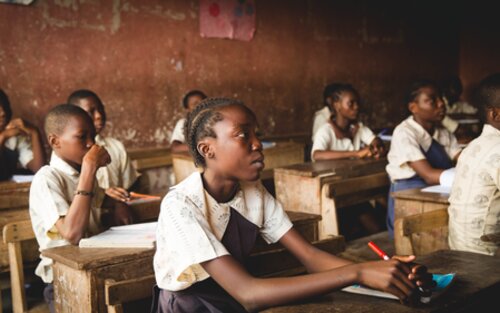You may be wondering: How do I support children with disabilities or developmental delays when I don’t have any training to do that? All children learn best in a developmentally appropriate program that offers them the supports they need to participate successfully alongside their classmates. Many children with disabilities benefit from simple accommodations and modifications, while other children may need more specialized, individualized supports provided by special education professionals.
To be an effective teacher, remember that regardless of individual needs, children are first and foremost children— and best practices for young children are best practices for all young children. Here are some ideas to help you set the stage for every child:
-
1
See the child as a child first
Each child is unique, and every child can learn. Look beyond a child’s disability or label, and get to know her as a person. Observe children to discover what interests each one and to get ideas about what might motivate her. Talking and playing with children provides important opportunities for building trusting relationships. Set learning goals, choose strategies, and assess children’s progress; and just as you do for all children, have high—but realistic— expectations for children with disabilities or developmental delays.
-
2
Re-examine your beliefs and knowledge
To be an excellent educator for all the children in your classroom, stay in touch with your inner teacher. Review both your understanding of child development and your toolkit of practices. Honestly examine your beliefs about children and families. Then think deeply about your responsibility to make learning—and the physical environment— engaging, developmentally appropriate, and accessible for all children.
-
3
Tap into the expertise of special education professionals
If a child has an identified disability or developmental delay, he receives services specified in his Individualized Education Program (IEP). The child’s teacher should either be given a copy of the IEP or opportunities to review it. Don’t hesitate to ask the special education teacher, early intervention coordinator, or administrator to explain anything that is confusing. They can help you adapt and modify your curriculum, physical space, materials, and educational expectations so the child can participate as fully as possible in classroom routines and activities. These professionals can also support you in identifying the child’s strengths and interests, helping you find relevant ways to connect your teaching to each child.
-
4
Make simple changes
Design the classroom space, routines, and activities so they are adaptable and can be used by the children in a variety of ways. This proactive approach supports children’s strengths and can be modified to address children’s needs. Plan activities that require more than one child’s participation to accomplish a task. Instead of an adult always working with a child with a disability, pair the child with a peer buddy. Provide dress-up items with multiple ways to fasten them. Find ways to absorb background noise to avoid distracting children.

